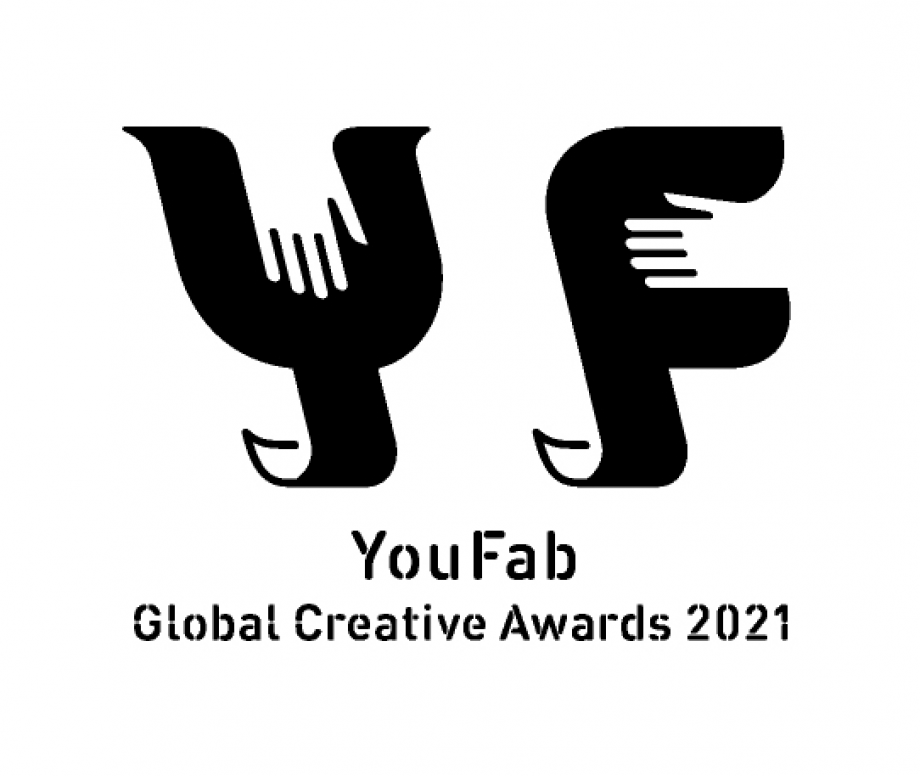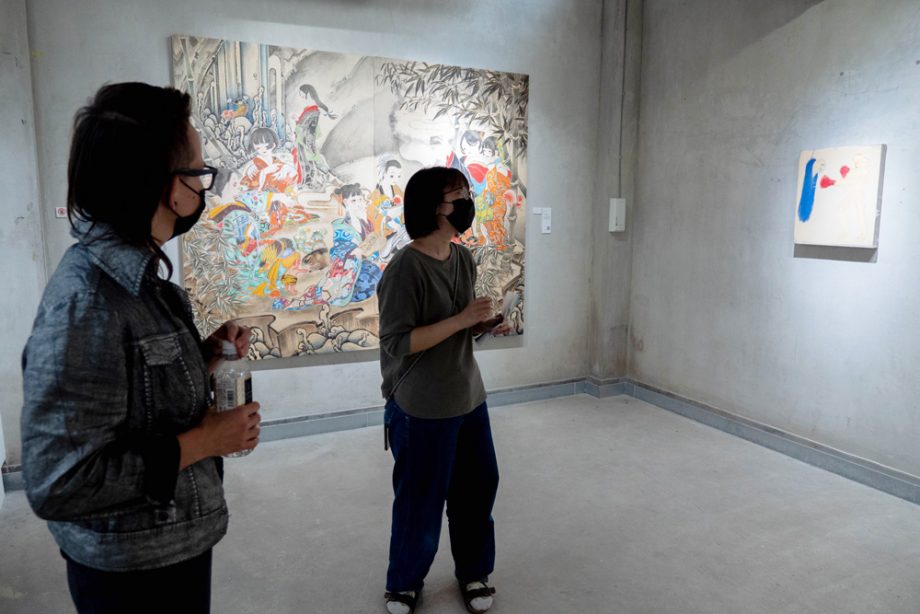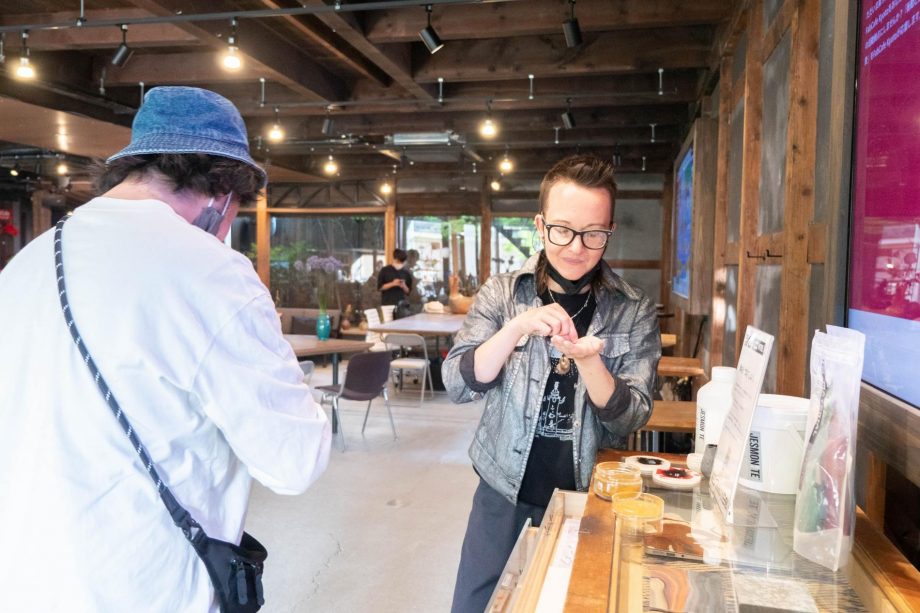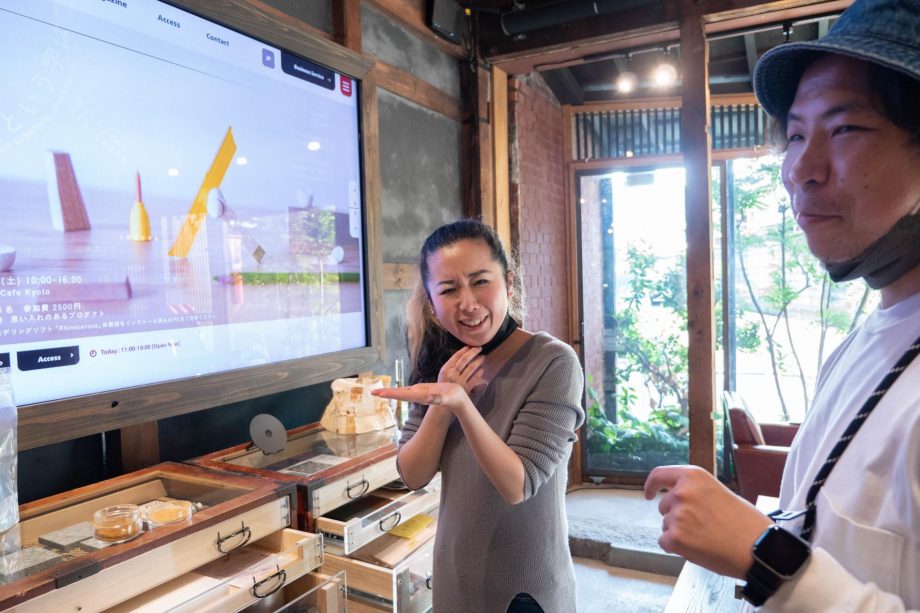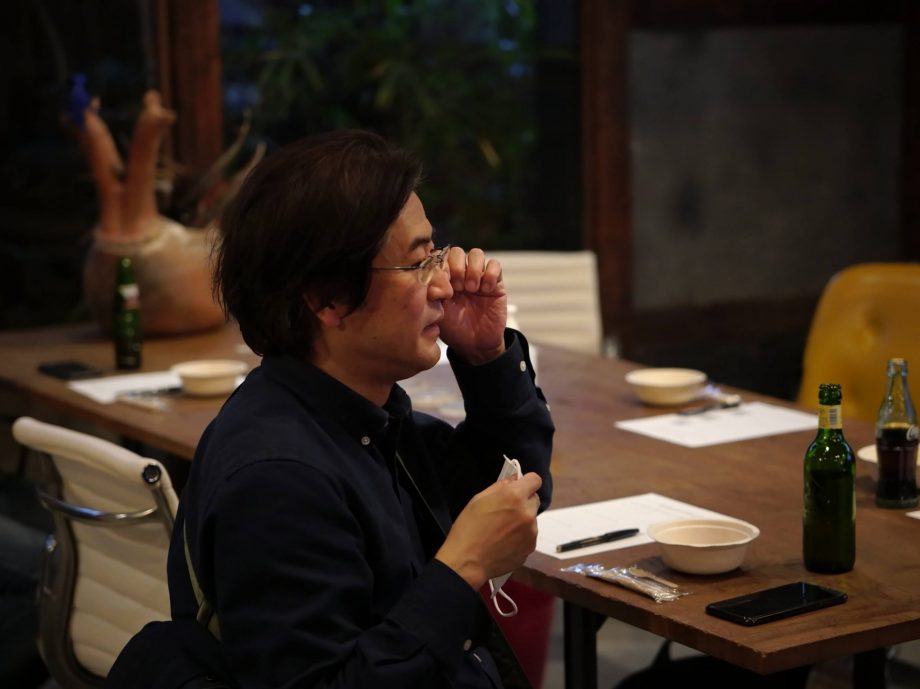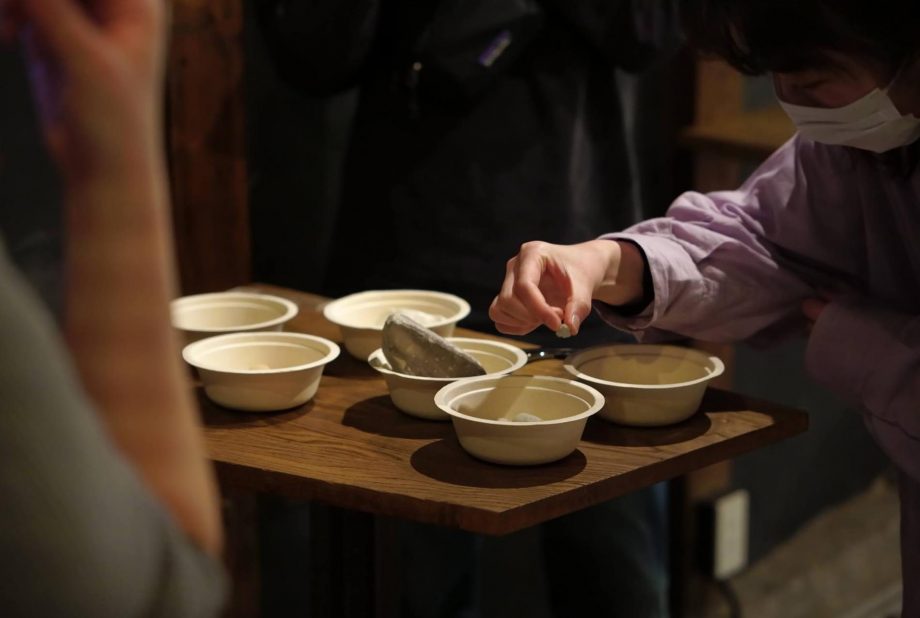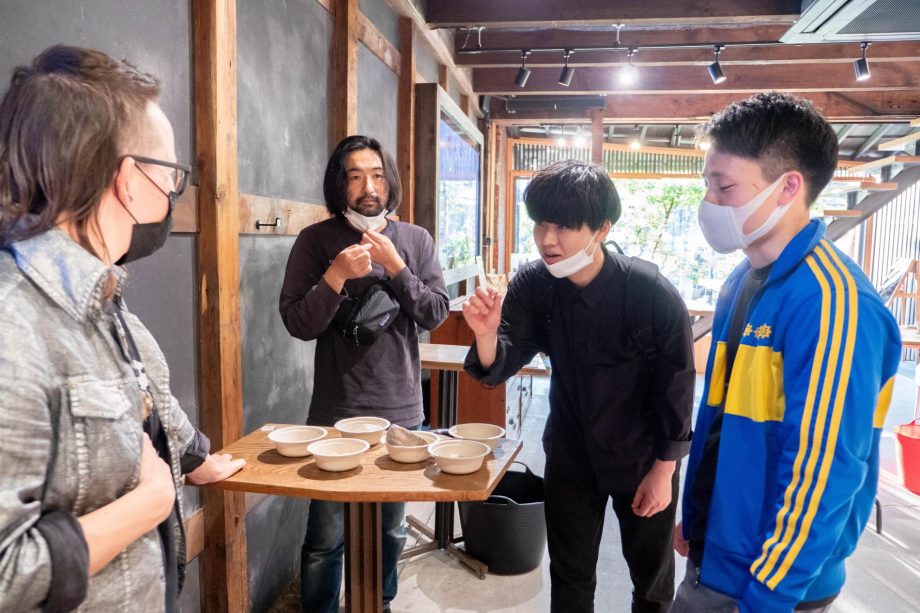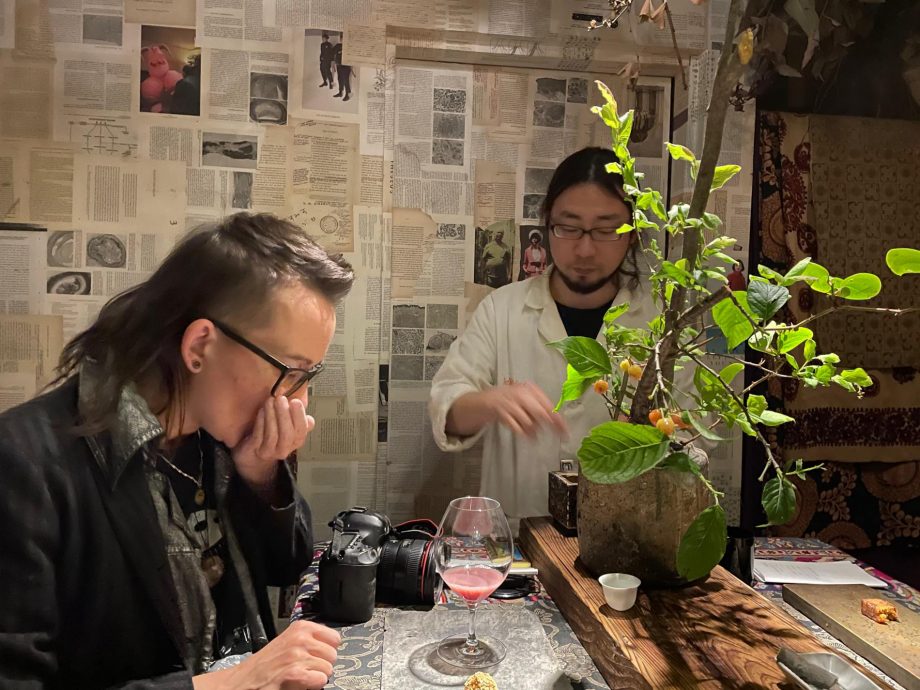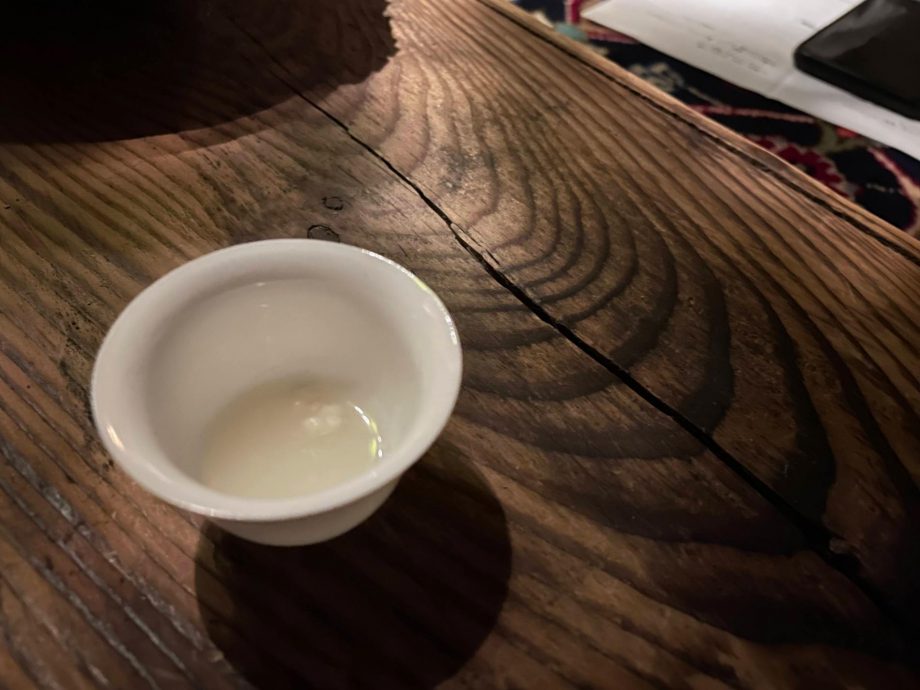Column
June 27, 2022
FabCafe Global Editorial Team
Hello everyone, this is Nami Urano from FabCafe Kyoto! On May 4, 2022, a sudden opportunity arose for the Netherlands-based artist and researcher masharu, Grand Prize winner of the YouFab Global Creative Awards 2021, to visit Kyoto. We quickly put together an intensive one-day tour program which included a fascinating earth-tasting session for local creators and researchers. Here I report the results of this brief but fruitful exchange!
-

-
Our visitor on this occasion: masharu
Netherlands-based masharu is the artist and researcher behind the mobile exhibition project of The Museum of Edible Earth, which gathers an extensive collection of edible earth samples and researches earth-eating cultures across the world. Through these practices, the Museum invites us to physically question our relationship with non-human beings, the environment, and our planet. FabCafe Tokyo invited masharu to Japan after their project won the Grand Prize at the YouFab Global Creative Awards 2021. During their stay, masharu offered an exhibition at FabCafe Tokyo and earth-tasting workshops at FabCafe Tokyo and Kyoto.
-

-
YouFab Global Creative Awards 2021
The YouFab award was launched by FabCafe in 2012. It first began as a competition for makers to simply come together, but quickly evolved into a platform to build and support the global creative community and to connect it directly with society.
In its 10th edition, the jury was headed by Dr. Asa Ito, Director of the Future of Humanity Research Center at the Institute of Innovative Research of the Tokyo Institute of Technology, who set the theme of “Democratic experiment(s)”. The 2021 award became the edition with the highest participation so far with 19 winners selected out of 335 works from 26 countries.
During their visit, masharu stayed at KAGAN HOTEL, an art hotel and hostel located in a renovated vegetable wholesaler’s women’s dormitory and warehouse located in Kyoto’s central wholesale market.
The large market and its surrounding area have become the city’s go-to creative hotspot, where several research and artistic facilities serve as a meeting point for local artists. It is a fascinating neighborhood where the ancient customs of Kyoto’s centuries-old food culture mingle with bold modern projects.

Photo by Atsushi Shiotani
KAGAN HOTEL is divided into an accommodation area, a cafe, an art gallery and a production studio. It also hosts artist-in-residence programs where participants can create and exhibit their work. Furthermore, KAGAN HOTEL has recently become a partner for the project-in-residence program COUNTER POINT run by FabCafe Kyoto: creators taking part in our program can enjoy discounted stays and may be offered the opportunity to exhibit their artworks there. If you are interested in participating, do not hesitate to contact us!
-

Art gallery area of KAGAN HOTEL. Both the second floor and the cafe area on the first floor can be used as exhibition spaces.
-

Production studio. Each artist-in-residence can use a personal production booth.
-

-
In Kyoto, streets are numbered from north to south: Ichijo (first street), Nijo (second street), Sanjo (third street), and so on. The Kyoto Imperial Palace, center of the intricate courtesan culture of ancient Japanese nobility, was located in Nijo, closer to the northern area. As we travel south and away from Imperial grounds, the culture of the common people gradually becomes more pronounced.
When we opened FabCafe Kyoto, we selected a location in the southern street of Gojo, quite far from the Imperial Palace; at the time we sensed that this peripheral “outsider area” would attract people embarking on new challenges and eventually become a fertile ground for interesting ideas to flourish. It turns out our instinct was right as it has now become the melting pot where the ancient and modern cultures of Kyoto give birth to fresh, edgy creativity.
When masharu arrived at FabCafe, producer Kosuke Kinoshita promptly introduced them to the different samples gathered by MTRL, an in-house project that researches the possibilities and applications of all kinds of materials. Our collection explores novel ways to use traditional textiles such as Nishijin fabric and kumihimo braids, as well as natural materials including urushi lacquer and Jomon cedar, alongside industrial materials such as reinforced cardboard and bio-leather. The Kyoto branch has a particularly extensive collection of samples, and everybody is welcome to come and discover them!

On the occasion of masharu’s visit, Kinoshita brought out a sample of mineral rock called limonite extracted from Mt. Aso, which is the largest volcano in Japan. He explained that limonite has been traditionally used as a deodorizer and pigment (red iron oxide, bengara in Japanese), as well as an ingredient in supplement. After hearing this, we all tasted it right away! masharu commented it was delicious, but I was a little confused because I had never tasted a rock before (laugh).

When we invited masharu to Kyoto, we swiftly organized a creative meetup as the central activity of the tour. We reached out to local researchers and artists interested in gastronomic practices, and even though it was Golden Week (one of the longest public holidays in Japan) we managed to gather a considerable number of participants. During the meetup, masharu presented the Museum of Edible Earth and provided edible earth samples from around the world so that participants could taste them and engage in casual discussion over cold beers.


masharu’s presentation started with the question: “Have you ever tasted earth?”
-

masharu has spent the last 10 years collecting more than 400 samples of edible earth from all over the world. The requisite for a particular sample to be added to the collection is to be consumed by at least one person.
-

Jun Rekimoto is the director of the Kyoto Laboratory at Sony Computer Science Laboratories. He researches body augmentation technologies as well as gastronomic practices, amongst others.
 We tasted three types of soil and shared our impressions.
We tasted three types of soil and shared our impressions.

Kazutoshi Tsuda is a bioresearcher at D-Lab/YCAM, Kyoto Institute of Technology. It looks like he is eating ice cream, but he is tasting soil!

Kyoto-based artist Kanako Shintaku’s bubbly laughter accompanied us during the whole session.

Participants tasted the samples and shared their comments with masharu. In this photo, we see Hiroaki Suzuki (left), founder of the cultural spot INTA-NET KYOTO, and Aki Yahata (right), researcher/artist investigating gastronomic cultures where people eat using their hands.

“Earthy and delicious”, “milky”… Although it was the first soil-tasting experience for most of the participants, they reflected upon their memories and experiences to convey their impressions.
-

masharu provided some extra samples in addition to the three main ones. Among them, the mineral soil from Congo was especially popular. We still have some left at FabCafe Kyoto, so please ask our staff if you want to try it!
-

Tsuda (left), Yusato Okuda (center), who is majoring in design research at Kyoto Institute of Technology, and Tanehiro Ogata (right), who is studying food tech at the D-Lab doctoral program at D-Lab as well as developing an education program, talk with masharu and try the samples.

After the presentation and tasting workshop, participants chatted casually, asking questions and introducing their own projects to masharu.
After the meetup, we took masharu to nokishita711, a liquid cuisine bar run by Sekine Motoiki. “It is not a cocktail, but a liquid dish,” Sekine explained, and each of his works was indeed completely different from ordinary cocktails: they included ingredients such as meat, fish or insects, and were prepared similarly to a restaurant meal, following procedures such as fermentation or extraction. Since Sekine also uses soil as an ingredient, his bar was a must-visit stop in our tour.

nokishita711 is situated in an alleyway a short distance from downtown Kyoto. (Photo by masharu)

Photo by masharu

Photo by masharu

When asked “When do you eat soil?”, masharu replied that they enjoy it as a luxury item, like cigarettes or snacks. They took out some of their soil samples and shared them with everyone to snack together while drinking. (Photo by masharu)

Photo by masharu
edalab floral artist Maeda joined us at the bar. She has collaborated many times with Sekine for the Drinkable Botanical Garden project, and is currently conducting the Inedible Flowers series of workshops at FabCafe Kyoto. Her expression here is priceless! (laugh) (Photo by masharu)
-

Sekine recommended masharu to try incense ash and pointed out that if it comes from high-quality incense, its fragrances won’t be lost even when added to a cocktail. The aroma was truly wonderful.
-

Koji fermented by Sekine himself. He wanted masharu to try it because it acquires the taste of the old earthenware pot where he ferments it.

At the end, Sekine prepared a cup of Chinese tea for us. It had a calming effect on our stomachs and hearts, which at that point were full of many flavors and ingredients.
In their single-day trip to Kyoto, masharu experienced many rich encounters. The former capital of Japan was, and still is, a dynamic city where all kinds of cultures meet, mix, and thrive. If you are looking into fueling your creativity and sparking new opportunities for your projects, don’t hesitate to contact us at FabCafe Kyoto! And we will gladly support you in every way we can.
Click here to learn more about our business services.
Click here to learn more about 3 month project-in-residence program COUNTERPOINT.

-
FabCafe Global Editorial Team
This articles is edited by FabCafe Global.
Please feel free to share your thoughts and opinions on this article with us.
→ Contact usThis articles is edited by FabCafe Global.
Please feel free to share your thoughts and opinions on this article with us.
→ Contact us


